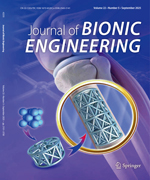|
|
Reconfigurable Muscle Strength Training Robot with Multi-mode Training for 17 Joint Movements
Jianfeng Li, Qiulin Fang, Mingjie Dong, Xi Rong, Liwei Jiang & Ran Jiao
Journal of Bionic Engineering. 2023, 20 (1):
212-224.
DOI: 10.1007/s42235-022-00254-5
Different from limb rehabilitation training, the purpose of muscle strength training is to reduce muscle atrophy and increase muscle strength and tolerance through strength training of limb muscles, and then improve the muscle strength level of muscles (groups), mainly for sports fitness and muscle strengthening groups and patients with muscle atrophy or muscle weakness caused by various diseases. In this paper, we developed a new reconfigurable muscle strength training robot, a bionic robot by imitating physicians to conduct muscle strength training for patients, which was developed with six training modes for 17 joint movements, that is, the shoulder flexion/extension, the shoulder internal/external rotation, the shoulder adduction/abduction, the elbow flexion/extension, the wrist supination/pronation, the wrist flexion/extension, the wrist radial/ulnar deviation, the hip flexion/extension, the hip internal/external rotation, the hip adduction/abduction, the knee flexion/extension, the ankle dorsiflexion/plantarflexion, the ankle adduction/abduction, the ankle inversion/eversion, the waist flexion/extension, the waist left/right rotation, and the waist left/right flexion. The reconfigurable mechanism was designed with fully electric adjuster and reconfigurable adaptors deployed on the driving unit, and six training modes were developed, namely, continuous passive motion, active exercise, passive–active exercise, isotonic exercise, isometric exercise and isokinetic exercise. Experiments with knee joint and elbow joint have shown that the developed reconfigurable muscle strength training robot can realize the multi-mode trainings for the 17 joint movements.
Related Articles |
Metrics
|

 Table of Content
Table of Content
 Table of Content
Table of Content